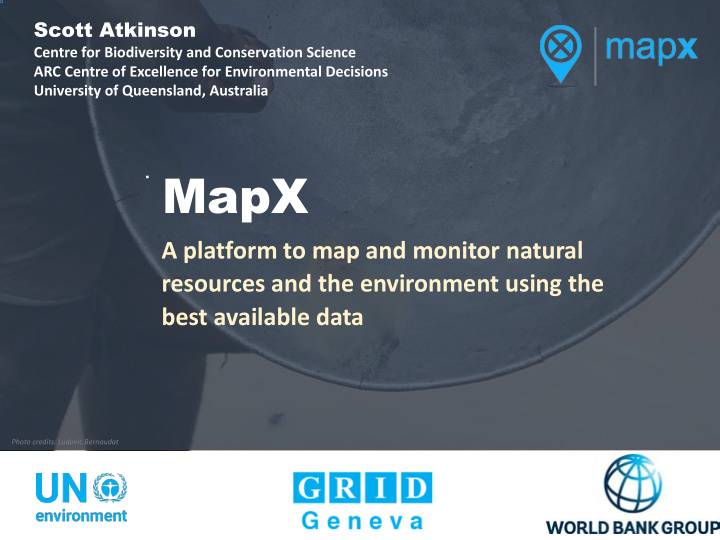



Scott Atkinson Centre for Biodiversity and Conservation Science ARC Centre of Excellence for Environmental Decisions University of Queensland, Australia MapX A platform to map and monitor natural resources and the environment using the best available data Photo credits: Ludovic Bernaudat
Outline: MapX overview and background. • Benefits of MapX. • Video examples of interface capabilities. • Photo credits: Ludovic Bernaudat
WHY USE GEOSPATIAL INFORMATION ? WHO USES GEOSPATIAL INFORMATION TO INFORM DECISION-MAKING ?
National Challenges Key problems faced by countries: - Insufficient spatial information for risk identification - Insufficient sharing of information among stakeholders - Insufficient uptake of information in decision-making and impact monitoring by all stakeholders 20 countries asked how the UN and World Bank could use emerging technologies to address these challenges. Information asymmetries lead to poor decisions & fragility
MapX Problem Space The digital revolution has given us greater access to data than ever before. However, in using this data to make better decisions about natural resources and the environment, stakeholders and UN agencies must address four key problems: DATA DATA QUALITY FRAGMENTATION DATA ACCESS DATA IMPACT
MapX Mission Build a neutral online platform that can help stakeholders: Share best available data • Make evidence-based decisions • Monitor development impact • Bring together complex technical data – within a sensitive political environment – in an impartial way.
MapX vs Google Maps ü Proprietary ü Open source / global public good ü Directions & street view × Directions & street view ü Satellite view ü Satellite view ü Attributes ü Attributes ü iframe / API ü iframe / API + Spatial data layer import / stream + Data integrity framework + Intersection & risk heat map + Time series + Data filters, rollups & dashboards + Areas of interest & alerts + Dynamic story maps
Problem Oriented Platform That is Customized to Support a Specific Process and Set of User Needs UN acts as an impartial and trusted third party to: A single cloud- based backend system and data Define user problem store that can power multiple front end Manage access Aggregate data applications powered by Customize application
Recap MapX is a Cloud Platform Offering Geospatial Tools to Map and Monitor Natural Resources & the Environment Tools to contextualize, analyze and visualize Global pool of best available data Alerts & dashboards for monitoring impact Story maps for communicating and outreach
What are the Benefits of The MapX Approach ? 1. Increased data sharing, integation, access, and solution focus 2. Strengthened data quality and confidence 3. Improved risk identification and evidence-driven prioritisation 4. Transparent monitoring of compliance and impact 5. Streamlined and simpified reporting 6. Dynamic communication of maps, photos, and videos 7. Open-source
MAP-X HARNESSING THE POWER OF SPATIAL DATA TO MAP AND MONITOR BIODIVERSITY: The next transparency revolution in the extractive industries
MapX Demo
Relevant Datasets for National Reporting
Filter and Query Datasets
Contextualize Datasets with Socio-Economic Data
Spatial Analysis Tool: Overlap Analysis
High-Resolution Satellite Images
Spatial Analysis Tool: Area of Selected Layer
Control and Secure Data Access
Upload Spatial Data
Export and Download Datasets
Create Maps from Selected Layers
Visualise Data Over Time
Customized Dashboards for Data Monitoring
Future Features to be Developed Improved map making. § More data layers and data providers, e.g., Human § Footprint, intact forests Systematic prioritisation (Marxan, ILP, etc.) § Integrated help for NP? § ….. § What would help your country! §
Human Footprint
Human Footprint Change
UNDP and MapX – Partnering to Provide Geospatial Intelligence to National Biodiversity Strategies and Action Plans Scott Atkinson www.mapx.org s.atkinson@uq.edu scottconsaulatkinson@gmail.com
Recommend
More recommend